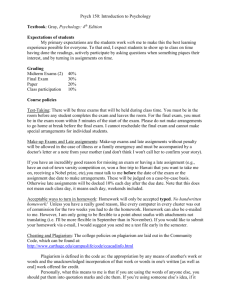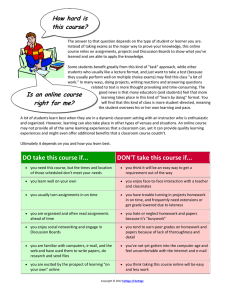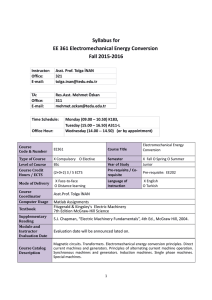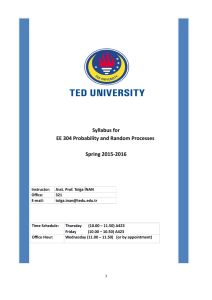Syllabus for EE 205 Software Tools for Electrical Engineering Fall
advertisement
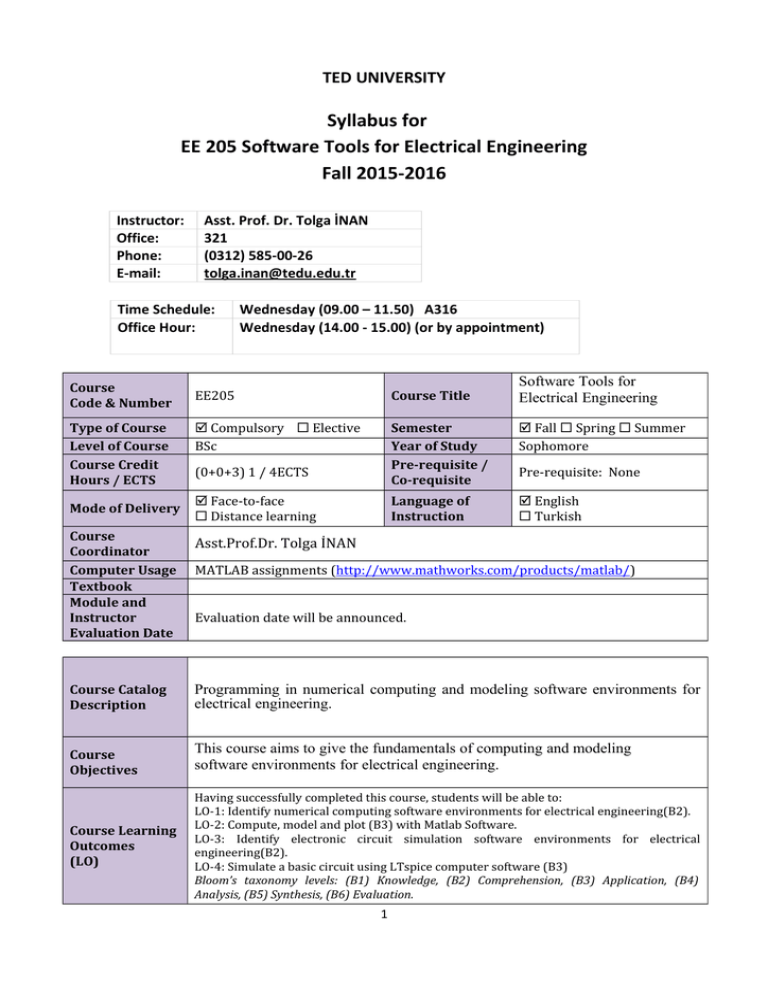
TED UNIVERSITY Syllabus for EE 205 Software Tools for Electrical Engineering Fall 2015-2016 Instructor: Office: Phone: E-mail: Asst. Prof. Dr. Tolga İNAN 321 (0312) 585-00-26 tolga.inan@tedu.edu.tr Time Schedule: Office Hour: Course Code & Number Type of Course Level of Course Course Credit Hours / ECTS Mode of Delivery Wednesday (09.00 – 11.50) A316 Wednesday (14.00 - 15.00) (or by appointment) Software Tools for Electrical Engineering EE205 Course Title Compulsory Elective BSc Semester Year of Study Pre-requisite / Co-requisite Fall Spring Summer Sophomore Language of Instruction English Turkish (0+0+3) 1 / 4ECTS Face-to-face Distance learning Pre-requisite: None Course Coordinator Computer Usage Textbook Module and Instructor Evaluation Date Asst.Prof.Dr. Tolga İNAN Course Catalog Description Programming in numerical computing and modeling software environments for electrical engineering. Course Objectives This course aims to give the fundamentals of computing and modeling software environments for electrical engineering. Course Learning Outcomes (LO) Having successfully completed this course, students will be able to: LO-1: Identify numerical computing software environments for electrical engineering(B2). LO-2: Compute, model and plot (B3) with Matlab Software. LO-3: Identify electronic circuit simulation software environments for electrical engineering(B2). LO-4: Simulate a basic circuit using LTspice computer software (B3) Bloom’s taxonomy levels: (B1) Knowledge, (B2) Comprehension, (B3) Application, (B4) Analysis, (B5) Synthesis, (B6) Evaluation. MATLAB assignments (http://www.mathworks.com/products/matlab/) Evaluation date will be announced. 1 TENTATIVE COURSE OUTLINE Week Date 1 9.9 2 16.9 3 23.9 4 30.9 5 7.10 6 14.10 7 21.10 8 28.10 9 4.11 10 11.11 11 18.11 Learning Outcome (LO) Topics MATLAB Overview of the computer hardware, Product Overview, Matlab Environment, Starting and quitting the MATLAB Help command and help menu Desktop tools and development environment, Command window, command history, Workspace browser and variable editor Expressions, Variables, Numbers Operators, Functions If, while, for Matrices and Arrays Matrix Operations Subscripts, Colon operator Working with Matrices Generating Matrices load, fscanf, fprintf, textscan Saving code to a m-file Concatenation Deleting rows and columns More about matrices and arrays Arrays, Multivariate Data Scalar Expansion Logical Subscripting FIND function Textbook Reading Assignments / Exams 1,2 1,2 Laboratory Assignment #1 1,2 Laboratory Assignment #2 Laboratory Assignment #3 1,2,4 Laboratory Assignment #4 Laboratory Assignment #5 More Maltab Commands else, elseif, pause, break, return, clear, close, tic, toc, why dir, cd, mkdir, rmdir, isdir Graphics Plotting Data figure, subplot, hold, cla, clf polar, rose, compass, ezpolar loglog, semilogx, semilogy Creating mesh and surface plots Understanding Handle Graphics Objects Interactive Data Exploration (Brushing) 1,2 1,2 Laboratory Assignment #6 1,2 Laboratory Assignment #7 1,2 LTspice (or a similar spice based simulation program) Introduction to the LTspice Interface 2 3,4 Laboratory Assignment #8 Laboratory Assignment #9 12 25.11 13 2.12 14 9.12 15 16.12 Draft a Design Using the Schematic Editor3, Run and Probe a Circuit Generating a Bill of Materials (BOM) and Efficiency Report 3,4 3,4 3,4 FINAL EXAMS WEEK, Date and time to be announced later. COURSE ASSIGNMENTS B. Final [19 %] There will be a cumulative closed-book final exam covering all topics. Date and time of the final will be announced at the end of the semester. C. Laboratory Assignments[81%] There will be 9 Laboratory Assignments,9 % for each one. COURSE ASSESSMENTS & LEARNING OUTCOMES MATRIX Assessment Methods Laboratory Assignments Final Exam Course Learning Outcomes LO # 1,2,3,4 LO # 1,2,3,4 Grade Scale 90-100 85-89 80-84 75-79 70-74 60-69 50-59 AA BA BB CB CC DC DD Teaching Methods & Learning Activities Telling/Explaining Questioning Reading Demonstrating Problem Solving Collaborating Oral Presentations/Reports Web Searching Project Assignments Assessment Methods (Formal & Informal) Test/Exam Presentation (Oral) Lab Assignments Student Workload (Total 117 Hrs) Lab Applications........................... 42 hrs Course Readings .......................... 25 hrs Exams/Quizzes ………….............. 25 hrs 3 COURSE POLICIES I. Attendance Regular class attendance is expected for all students at the University. You are not required but advised to attend all classes. Please sign the attendance sheet when you come to the class. Any false signatures will result in zero participation grades for all parties involved. Your absence will not reduce your attendance rate if and only if you have a legitimate reason for missing a class (such as illness, death in family, a traffic accident, etc.). In case of an illness or emergency, you must supply a formal documentation that supports your claim. II. Make-up Exams Make-Up for the Final Examwill be available if and only if you have a legitimate reason for missing the exam (such as illness, death in family, a traffic accident, etc.). In case of an illness or emergency, you must supply a formal documentation that supports your claim. III. Late Submission Policy Late submissions will be graded zero. There will be no make-up for laborotory assignments. Missed assignments will result in a grade of zero (0). IV. Cheating & Plagiarism Collaboration is strongly encouraged; however, the work you hand in must be solely your own. Cheating and plagiarism are very serious offenses and will be penalized accordingly by the university disciplinary committee. Cheating has a very broad description which can be summarized as "acting dishonestly". Some of the things that can be considered as cheating are the following: - Copying answers on exams, projects and lab works, - Using prohibited material on exams, - Lying to gain any type of advantage in class, - Providing false, modified or forged data in a report, - Plagiarising (see below), - Modifying graded material to be re-graded, - Causing harm to colleagues by distributing false information about an exam, homework or lab. All of the following are considered plagiarism: - Turning in someone else's work as your own, - Copying words or ideas from someone else without giving credit, - Failing to put a quotation in quotation marks, - Giving incorrect information about the source of a quotation, - Changing words but copying the sentence structure of a source without giving credit, - Copying so many words or ideas from a source that it makes up the majority of your work, whether you give credit or not. (www.plagiarism.org) V. Disability Support If you have a disabling condition which may interfere with your ability to successfully complete this course, please contact Dr. Aslı Bugay (email: asli.bugay@tedu.edu.tr ) or Dr. Tolga İnan (email: tolga.inan@tedu.edu.tr). For more information please see Handbook for Registered Students. 4
